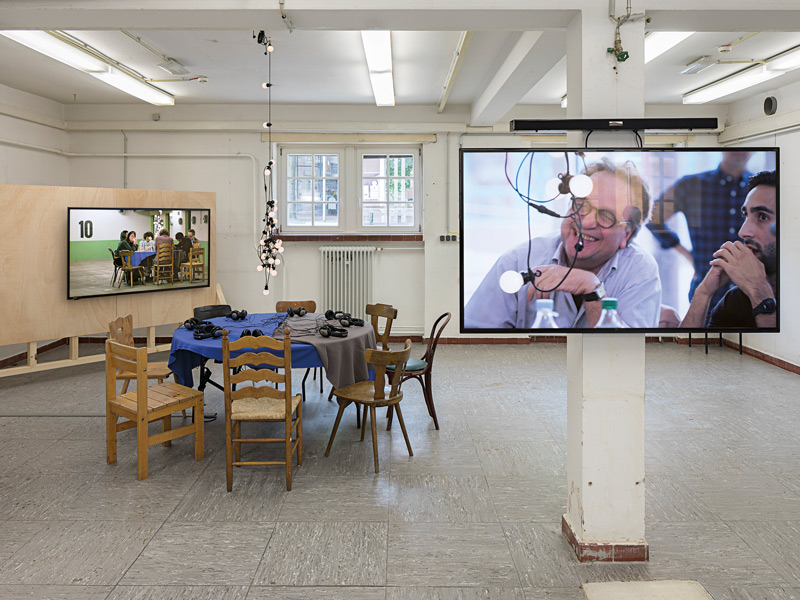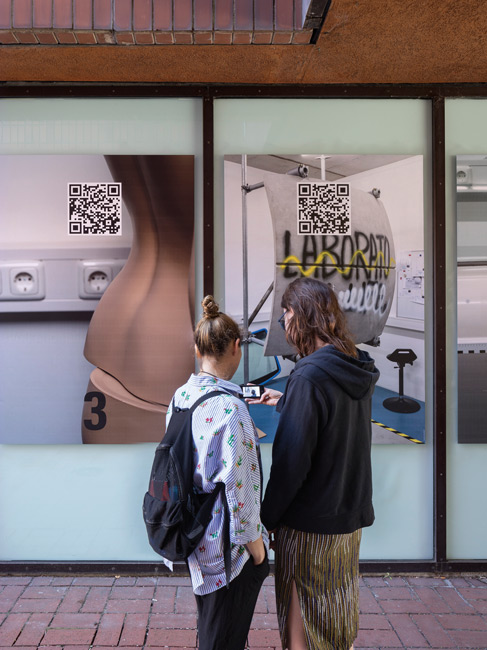Munster, Germany
June 10 to October 1, 2017
By Lon Dubinsky
The fifth Skulptur Projekte Münster was held this past spring and summer, as were documenta 14 and the Venice Biennale, making Europe a very desirable destination in the art world in 2017. The Münster event has taken place every ten years since 1977. The pedestrian- and cyclist-friendly city is not large, and its central core with a surrounding leafy promenade contained many outdoor works and indoor installations. One had to venture several kilometres to see many works, such as a techno-organic structure by Pierre Huyghe in a former ice skating rink and three works in and adjacent to the Pumpenhaus, a theatre and community space in a residential area in the north of the city. And for the first time the exhibition ventured outside of Münster to Marl, a post-industrial city about forty minutes away, where it presented The Hot Line in collaboration with Marl’s sculpture museum.
Nonetheless, there was something admirably slow – at times, even relaxed – about the experience that was perhaps best expressed by Nicole Eisenman’s exaggerated bronze figures lounging around a park pool. The entire exhibition was a welcome respite from the usual relentless pace of urban life as one wandered, map in hand, to find the sculptures in this year’s edition, as well as permanent ones from previous editions. Some – such as Sany’s beguilingly cartoon-like figures on buildings in Munster and Marl and Justin Matherly’s conventionally appealing Nietzsche’s Rock, shaped like a battle tank – were easy to locate. Others were not immediately apparent. Gerard Byrne’s video installation, consisting of cleverly edited footage of disc-jockey radio broadcasts from the 1960s and 1970s, was located, appropriately, in a music room in the basement of the municipal library. The remoteness of the space, where one could rest one’s elbows on a grand piano while watching and listening, lent itself to the privacy of the experience within this public institution.
By contrast, only in retrospect did I realize that I had seen Thomas Schütte’s Nuclear Temple, owing to an enormously crowded all-day flea market that had engulfed the sculpture during my attempts to find it. The Buddhist- like structure seemed so solitary and ascetic when compared to other works, including Cosima van Bonin and Tom Burr’s Mercedes truck-trailer and container in front of the entrance to thenLWL Museum – the central location and headquarters of the exhibition in the city’s core. This in-your-face work had an irreverence and irony about it, especially since the pristine lines and white walls of the museum, the sleek Mercedes and the permanent Henry Moore sculpture next to it have kindred modernist origins. There were other works in and beside the museum, but most notable was Double Check, an archival display about the work of the late Michael Asher that had appeared in all previous editions and was the first of several planned exhibitions dedicated to presenting the history of the Skulptur Projekte Münster.
Asher’s serial work in which a caravan truck made a repeated appearance over a thirty-year period called to mind other artists in previous editions, such as Schütte, von Bonin, and Jeremy Deller, whose work was located in a community garden adjacent to the Pumpenhaus. For the 2007 edition, Deller asked fifty garden-allotment associations through- out Munster to keep records of their activities during the ensuing decade. In 2017, about thirty-three of these records were displayed in a tiny cabin in one of the allotments, providing another temporal linkage that was integral to the purpose and pace of this year’s exhibition. Time also figured in the two other works at the Pumpenhaus; one by Aram Bartholl converted fire, one of the earliest forms of signalling, into electrical energy as one sat in a campfire setting to witness the transformation. Inside the Pumpenhaus, the Gildsdorfer/ Klassen troupe staged daily performances, some improvised and others planned, featuring actors, dancers, and artists who brought emotion, humour, and critique to topics such as cultural identity, colonialism, and consumerism. These themes also resonated in Mika Rottenberg’s film installation, in a former Asia Food Shop situated on the way to the Pumpenhaus, that chronicled workers becoming overwhelmed as they repetitively assembled and packed all matter of goods.
The Gilsdorfer/Klassen performances were one of several collaborative works, located in interior spaces that made the 2017 edition particularly interactive. In a basement and adjoining small courtyard were Koki Tanaka’s videos documenting the experiences of several Munster residents from various cultural back- grounds who he brought together to “deal with living together over a ten day period.” In a completely different vein, I felt like a participant-observer in Ayse Erkmen’s work, an invisible footbridge linking two sides of the city’s inner harbour which people crossed, looking as if they were walking on water, as throngs looked on. If actual participation and geography were not determining factors, the interactive digital presence was, in an understated fashion, as evidenced by Andres Bunte’s posters of images from his film series Laboratory Life. Located in three exterior sites and also accessible via an app using QR codes on the wall works, they were perhaps the only in- stance of stand-alone photographs in the exhibition.
In a review of any group exhibition, it is near impossible to include every artist, but this does not stop me from second-guessing the choices made by the curators, Kasper Konig, Britta Peters, and Marianne Wagner. Although I could envisage many scenarios, the 2017 Skulptur Projekte Münster did not come up short. There were no stand-out pieces; what mattered most was that the thirty-five-plus works were an en- gaged ensemble spread across Munster and as far as Marl, with work by some artists, such as Sany, in both places. The ensemble was long on nuance, even though several works addressed acute political and social-economic issues such as identity, class, and migration; this was a very different tack, it must be noted, than that taken by documenta 14 in Kassel, about three hours away, which was marked by extensively and overtly political works. Unlike in documenta, artists in Munster were not identified by their national affiliations; nevertheless, the public programmers were very mindful of the city’s increasing cultural diversity and offered guided tours in many languages: the expected German, English, Dutch, and French, but also Farsi, Russian, Kurdish, Arabic, and introductory German for new speakers. Cultural and social differences were also explicit in contrasts between Munster and Marl – the former a congenial and green urban space with a major university, strong Catholic traditions, and centrist politics; the latter a rust-belt city coping with industrial decline.
What the 2017 edition was ultimately about was time – time in conception, tenor, tone, and content. Traces of the past were everywhere in current and permanent works and in the event’s very durability. There was also a heightened sense “of living through the art works,” more for residents than for visitors, as Claire Doherty noted in her essay in the exhibition catalogue.1 Yet the 2017 Skulptur Projekte Münster also provided time to contemplate the cultural future, which was a redemptive gift in an otherwise frenetic world where what seems forebodingly ahead is much too soon upon us.
Lon Dubinsky teaches in the undergraduate and master’s studio arts programs at Concordia University. He has undertaken curatorial and consultative work for many galleries, museums, and cities, most recently Galerie Stewart Hall. In his current research, he is focusing on rethinking public art, using as case studies UP Projects in London, UK; the Art and the Public Realm program of Bristol, UK; and Skulptur Projekte Münster.
[See the printed or digital version of the magazine for the complete article. On sale here : Ciel variable 108 – GOING PUBLIC ]
Purchase this article



